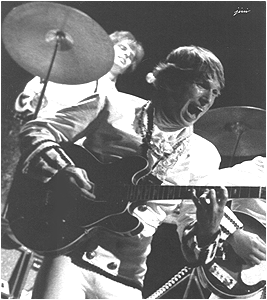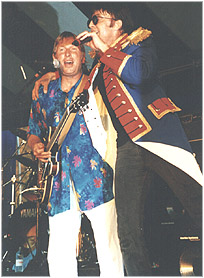
|
THE WAY THEY WERE By Russell R. Holster Jr.
Few bands in the history of rock and roll have had more ups and downs than Paul Revere and the Raiders. Rarely mentioned these days in the same breath with the all-time rock and roll greats, Paul Revere and the Raiders once seemed bigger than the Beatles. OK, only for a short while... and only in America... and in retrospect thanks largely to the power of television and the teeny-bopper press. Nevertheless... The years were 1965 and 1966. The Beatles' Capitol Records album Beatles VI was their most lackluster, and they weren't even selling out their American concerts. Herman's Hermits, the Dave Clark Five, Freddie and the Dreamers, Gerry & the Pacemakers, were headed on a downward spiral or already spent. The vaunted "British Invasion" was visibly and aurally losing steam. So, too, the New York folkie scene was losing momentum. many of its prominent members heading west. California, Los Angeles, in particular, appeared to be where the newest musical sun was rising. As the Beach Boys were morphing from novelty act to impressive song crafters, a new pop music television show, appropriately titled "Where the Action Is" debuted to great appeal, and its star attraction was a relatively unknown group nationally, Paul Revere and the Raiders.
Initially based in Boise, Idaho, the Raiders soon moved to Portland, Oregon and became a local phenomenon in the Pacific Northwest, perfecting a campy, raucous brand of rock and roll. Along with other Northwest rockers, such as the Fabulous Wailers and the Sonics, Paul Revere and the Raiders were among the progenitors of what would come to be known as the "garage band." By the time Dick Clark hand-picked them to be the "house band" on this new TV show, the Raiders already had plenty of swagger. Combining a jangly blend of blue-eyed soul, oldtime rock and roll and twanging 60s guitars, powered by a wild and crazy stage act custom-made for TV, the Raiders were stars before they had a big hit single. The Action-era Raiders were brimming with charisma. Fronted by Mark Lindsay, with trademark ponytail and breathy vocals (and decent sax player), joined by baby-faced bass player Phil "Fang" Volk, stylish guitarist Drake Levin, cool and steady drummer Mike "Smitty" Smith, and uncle figure/madcap leader Paul Revere... all decked out in funky colonial costume, the Raiders were nothing if not colorful. They quickly soared from Action's "backup band" to front and center stars. But it didn't take long for the hits to come rolling along. And
they did roll: Just Like Me, Kicks, Hungry and Good Thing are the
classics, with Steppin' Out, Great Airplane Strike, Ups and Downs
and Him or Me a notch below for the prime time Raiders. A distinction must be made because through their history (actually continuing to this day) there have been many Paul Revere and the Raiders. Only Paul Revere has been in all of them. Lead singer Lindsay was in from the start through 1975, when he finally bailed to concentrate on a solo career which had produced two hits, "Silverbird" and "Arizona" while he was with the Raiders but would flounder after he officially left the group. In the early days and after their Action years, quite a number of players called themselves Raiders. Besides Lindsay, three other Raiders enjoyed some measure of solo success. Levin's replacement as lead guitarist, Jim Valley, would be signed by a major label and go on to eventually release several albums, including a popular series of children's music CDs. The guitarist who took over for Valley, Freddy Weller, rocked with the Raiders from 1968 through 1973, but also scored hits on his own as a country star while he was with the Raiders and for some years afterward. Third generation Raider bass player, Keith Allison, originally made a splash on "Where the Action Is" as a solo artist. Despite a Columbia Records album and massive teen magazine hype, the Allison star-making machine never quite succeeded, and he joined the Raiders in 1969. However, Allison is still making music in the L.A. scene today as a respected session player, guitarist and singer. But for those of us who loved them in their prime, there were only six real Raiders: the original Action boys -- Paul, Mark, Smitty, Drake, Fang -- and in 1966 Drake's replacement, Jim Valley, whose Raider moniker was "Harpo".
Drake had been, literally, instrumental in
crafting the mid-60s Raiders sound. It was his double-tracked
signature guitar riffs, as much as Lindsay's voice and Terry
Melcher's production work, that carried "Steppin' Out", "Just Like Me" and "Kicks".
Upon Drake's departure in the spring of '66, Revere plucked Jim
Valley out of a kindred Northwest band, Don & the Goodtimes,
noticed a resemblance to Marx Brother Harpo, and thus dubbed the
newest Raider. Jim joined the guys on Action, in the studio and
on a furious tour schedule, just as "Hungry", "Good
Thing" and "Great Airplane Strike" soared toward
the top of the charts. His personality, if anything even brighter
than Drake's, swept over any reluctance true fans felt over Levin's
departure. * * * * * * * * *
The first Raider that I saw was Jim Valley. Star-struck, I gushed, "I know who you are, you're Harpo!" "Yeah, Hi," Jim said in return. That was it, verbatim. I remember because I wrote it down in my journal the next day. I met the other band members, too, along with Keith Allison, the Robbs and Steve Alaimo, and remember them all as being cordial though none of their comments were recorded for posterity. Little could I, or any of the hundreds of thousands of devoted Paul Revere and the Raiders fans who saw them in concert that year, have realized that the end was near for Harpo as a Raider and for the Raiders as a relevant rock and roll band. Jim left the group in early '67 because of musical and lifestyle differences with Revere, Melcher and Lindsay. Primarily he was frustrated that he was not given the opportunity to meaningfully contribute to the band's musical direction and song collection. As the hits "Ups and Downs" and "Him Or Me" danced upon the airwaves, Jim Valley, his guitar and his smile stepped into pop music oblivion... at least for awhile.
For me, and I think many other PR&R fans, the group lost its relevance when its power trio said goodbye in 1967. Harpo, Fang and Smitty were replaced by Weller, Charlie Coe and Joe Correro Jr., respectively (Keith Allison would later replace Coe as bassist for an extended run). Arguably, these players were perhaps stronger musicians than the guys they replaced, but only a string of less than classic hits ensued: "I Had A Dream", "Peace Of Mind" (after which Melcher ceased to work with the band), "Too Much Talk", "Don't Take It So Hard" (probably the best of this bunch of records), "Cinderella Sunshine", "Mr. Sun, Mr. Moon", "Let Me", "We Gotta All Get Together". By 1970-71, Lindsay had scored big solo hits with "Silverbird" and "Arizona". However, he was still officially a member of the Raiders... who desperately needed a hit. Lindsay offered Revere his already-recorded song, "Indian Reservation". In the summer of 1971, the song reached No. 1 on the charts, the first and only Raiders' song to manage that feat. But it was a novelty song... not a true rock and roll band number. Rather than revitalizing Paul Revere and the Raiders, "Indian Reservation" was the group's swansong... in much the same manner as Three Dog Night's "Joy to the World" and Glen Campbell's "Rhinestone Cowboy", their biggest hits, also signaled the end of their primal, hit-making careers.
In retrospect, Paul Revere and the Raiders were always a novelty band. Mugging for the camera, it often seemed as if fun came first, music second with the Raiders. That formula worked brilliantly early on. But the schtick that brought them their first fame did not wear well as the 60s progressed. Still, the "novelty" term could be applied to many revered rock and rollers, including Chuck Berry, Little Richard, Jerry Lee Lewis, Buddy Holly, and later, David Bowie and Elton John, just to name a few. Even as they were camping it up, Paul Revere
and the Raiders sprang from the organic garage band Northwest scene, and in L.A. managed to craft some of the 60s best pop songs. "Just Like Me", "Kicks" and "Hungry" stand
as three of rock and roll's all-time anthems... and Mark Lindsay's
pipes are perhaps the most underrated in the history of rock. Moreover, the Raiders were a transition band, from the bubblegum early 60s to the harder rock of late 1960s. Often not included in the Raiders' list of "hits" are a couple of seminal tunes that they released first, but another band charted higher with, "Louie Louie" by the Kingsmen and "I'm Not You're Stepping Stone" for the Monkees. Taking into account all of their original credibility, their television appearances (some estimate the Raiders have been on TV more than any other rock and roll act), their mega hits and would-be hits, the viability of these hits decades later (as evidenced by the soundtrack to "Once Upon a Time... in Hollywood"), there is no doubt that Paul Revere and the Raiders should be in the Rock and Roll Hall of Fame. The millions of fans who bought their records, relished those TV performances, and saw their shows during their decades-long run in Las Vegas, would surely agree. Jim Valley's last performance with Paul Revere and the Raiders. Seattle, 1967 No doubt, the Raiders were a fun band... and for just a short
year or two, the coolest of the cool. I think I speak for many
thousands of Raiders fans in saying a smile still always comes
to my face and the foot still starts tapping whenever I hear Paul
Revere and the Raiders. Thanks, guys for the way you were.
* * * * * * * * *
THIRTY YEARS ON...I met up with Jim Valley again 32 years later in Gig Harbor, Washington. He was performing for a group of children, who were mesmerized by his songs and his charm. As I watched I was mesmerized, too. There was a bit of my youth before me, "Harpo" of Paul Revere and the Raiders. The eyes I had seen before, long ago. The voice I had heard before. The music I had not. What was this rather un-Raider-like incarnation? I listened, opened once again to Jim Valley's guitar, and loved what I heard. I walked up to him afterward and exclaimed, "Jim, last time I laid eyes on you was in Texas, 1966." He looked perplexed, then smiled, "Paul Revere and the Raiders." Since that day we have become friends, made some music together, and worked on the Rainbow Planet web site. I feel as if I truly have discovered a long lost friend, one whom I didn't get a chance to really know long ago. What I have noticed is that magic hangs close to Jim Valley. He lives in a magical world, and draws upon that enchantment in sharing music and ideas that are more beautiful and relevant than anything by Paul Revere and the Raiders. That's not to disparage the Raiders. They were right and timely in 1965-66. J.V. is right and timely for the new millennium.
One day recently I called Jim and invited him to go to a concert with me in University Place (near Tacoma)... to see a singer by the name of Mark Lindsay. The next thing I know Mark is announcing to a standing-room only crowd that "a very special guest is in the audience... the guy who played guitar on all those Paul Revere and the Raider hits... please welcome "Harpo!!!" Drake may have choked on Lindsay's introduction, but the audience didn't know any better and loved it. There before our eyes was Mark in his Raider coat and Jim with a Gibson 335, arm-in-arm, sounding great singing "Good Thing", and doing the Raider step-dance. A snippet of 1966 time-warped to 1998. I scanned the audience. All eyes, some misty with sheer joy, were riveted on the two "real" Raiders, once again bringing a darned good thing to their fans. As Mark continued with his show (and he sounds as great as ever, by the way), Jim patiently signed autographs for a slew of middle-aged folks shoving ragged Raiders album covers and old faded black-and-white glossies at him. One lady carried a portfolio of pencil portraits she had drawn in 1966. There was heartthrob Mark Lindsay. She had renditions of "Fang" and "Smitty" and the ever-present Paul Revere. And in the back of the portfolio she had a remarkable charcoal-smudged likeness of a 20-year-old kid with the wacky nickname "Harpo."
The fun-loving spirit of Harpo lives on in Jim's music today... except not as a caricature but fully realized in all of the multiple dimensions through which Jim Valley cavorts. Ironically, the primary beneficiaries of his modern-day musical alchemy are the kids, or even the kids of the kids, of we old Raiders fans. That still seems a bit strange to me. Wasn't it only a very short time ago that I was watching Jim onstage with Paul Revere and the Raiders? And now here he is, 30 years on, crafting a career that is exponentially more important than his first fling with fame. You have to root for Jim Valley. He is a rare soul, a natural born entertainer, a magical songwriter, gifted singer and all-around good guy. And he has friends in all the right places... the children of the world... who know a good thing when they hear it. |

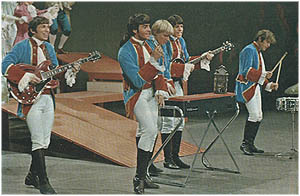

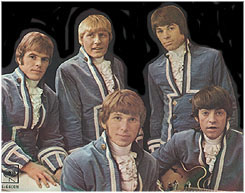
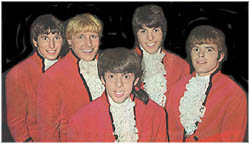 In those days, a band's persona, its image in the eyes of its
fans, was created and sustained not only by the music but also
by the sense of comraderie, commitment and personality that the
group reflected. Few groups could boast that their fans knew, by
first name or nickname, all of their members. In that number were
the Beatles, the Stones, later on the Monkees, and in 1965, Paul
Revere and the Raiders. So it was with anxiety that Raider fans
learned in 1966 that guitarist Drake had left the group to join
the National Guard before being drafted.
In those days, a band's persona, its image in the eyes of its
fans, was created and sustained not only by the music but also
by the sense of comraderie, commitment and personality that the
group reflected. Few groups could boast that their fans knew, by
first name or nickname, all of their members. In that number were
the Beatles, the Stones, later on the Monkees, and in 1965, Paul
Revere and the Raiders. So it was with anxiety that Raider fans
learned in 1966 that guitarist Drake had left the group to join
the National Guard before being drafted.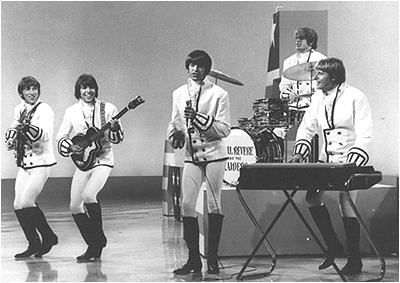
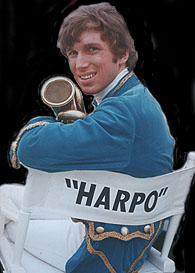 When Harpo, and soon after Fang and Smitty,
left the group, the final illusion evaporated of Paul Revere and the Raiders
as a real rock and roll unit, in the sense of integral involvment of essential members like in the Beatles, Rolling Stones, Beach Boys, etc. Left behind were Lindsay,
Paul Revere and producer Terry Melcher, revealed
as Oz-like men behind the curtain of a hit-making machine. Like the Monkees, the Raiders lost credibility as artists, and any rebuilding of that gravitas
was about to be short circuited by a rising tide of truly authentic
rockers such as Eric Clapton, Jimi Hendrix, the San Francisco
groups, the Doors, not to mention the resurgent genius of the
Beatles.
When Harpo, and soon after Fang and Smitty,
left the group, the final illusion evaporated of Paul Revere and the Raiders
as a real rock and roll unit, in the sense of integral involvment of essential members like in the Beatles, Rolling Stones, Beach Boys, etc. Left behind were Lindsay,
Paul Revere and producer Terry Melcher, revealed
as Oz-like men behind the curtain of a hit-making machine. Like the Monkees, the Raiders lost credibility as artists, and any rebuilding of that gravitas
was about to be short circuited by a rising tide of truly authentic
rockers such as Eric Clapton, Jimi Hendrix, the San Francisco
groups, the Doors, not to mention the resurgent genius of the
Beatles. 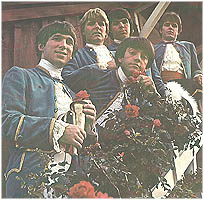 And so Paul Revere and the Raiders ceased to
exist as a recording band. Lindsay's solo career likewise came
to an unheralded end. By 1977, he had "retired" from
music. Little by little, they have been largely forgotten, unadored
by music critics and coolsters.
And so Paul Revere and the Raiders ceased to
exist as a recording band. Lindsay's solo career likewise came
to an unheralded end. By 1977, he had "retired" from
music. Little by little, they have been largely forgotten, unadored
by music critics and coolsters.